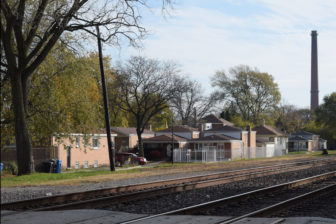Shari Henry breathed a sigh of relief at the news.
The home she shares with her mother will not be taken to make way for the planned Red Line extension to the city’s southern limits. She and her mother had been in a holding pattern since they received a letter in 2016 from the Chicago Transit Authority stating that their home was among 248 that could be acquired for the project. The Henry family home was among 94 privately owned properties that ended up being spared in CTA’s final plan, announced late last week. Only 154 properties will have to be acquired.
“Just so much has been on hold because we’ve haven’t known,” said Henry, whose parents bought their house in the Fernwood neighborhood in 1970 after leaving the Dearborn Homes housing development. She had been putting off installing a new roof. “There was no need to do a roof if the house was going to be taken, if it was going to be torn down.”
CTA’s initial proposal included options for building the extension on either the east or west side of the Union Pacific Railroad tracks that stretch through the Far South Side. But the agency decided to use a hybrid of the two options: The elevated transit line will run west of the Union Pacific tracks from I-57, running partly on a grassy parkway, to 109th Street. There, it will cross over to the east side and continue south to the last of four new stops, at 130th Street in the Riverdale community.
The Henry’s home was spared by the use of that 4-block stretch of green space. The majority of line will run along the east side, which is mostly residential but has more vacant properties that could be used for economic development.
But other residents will still be uprooted from their homes or businesses. Mims Donald will have to uproot the family-owned business that is in the extension’s path. He has operated Donald’s Auto Repair at the corner of West 115th Street and South Lafayette Avenue since his family first bought the business in 1976. CTA has proposed to build one of the four new stations in the area.
Still, Donald believes the extension is a good thing. “I’ll be glad to see something coming in that improves the neighborhood,” said Donald. “I am all for anything in this neighborhood that is going to help it.”
Donald lived in the community for more than 30 years before moving to Calumet City. He said Roseland is not the same great neighborhood he once grew up in.
“Things just steady been going down because people can’t get any jobs,” he said. “Anything that is going to improve for people to get better jobs and have better transportation to get downtown … I am all for it. I can establish another business some other place. I am not gonna stand in the way.”
Donald is optimistic about the development as well as getting a fair price for his property. But other residents have been skeptical about the potential impact of the project on home value and the prospects for economic development. The area has long suffered from a lack of jobs, poor transit options to employment, and disinvestment as blacks moved in and whites fled to the suburbs during the 1950s and 60s.
| RELATED
Far South Side homeowners question Red Line extension’s impact on property values |
The city’s history of residential segregation has kept home values down. Coupled with the recent housing crisis, experts say homeowners may not get their original purchase price for their homes once the city begins acquiring properties. Home prices in Roseland, Riverdale and other Far South Side communities fell further during the housing crisis and recovered more slowly compared to the rest of Chicago.
Ald. Anthony Beale, whose 9th Ward encompass the majority of the Red Line extension, recognizes the residents’ concerns about getting a fair price for their property but says residents will get a fair shake.
“Nobody is coming out of this short-handed, and I am gonna make sure of that,” said Beale. He called the hybrid alignment a win-win for the community that minimizes displacement.
Beale is optimistic about the project, which has been more than 40 years in the making, but says he cannot get excited until the funding is secure. City and CTA officials expressed confidence about securing additional federal and state funding and have already secured $85 million for engineering and environmental work. The earliest construction would begin is 2022. The project would take four years to complete.
The 5.3-mile extension will include four new stations with park ‘n ride lots and bus connections, on 103rd Street, 111th Street, 115th and Michigan Avenue, and 130th Street. Studies have shown that on average property values near transit tend to increase. But areas suffering from low home values for a long time may not see an immediate increase. Instead, home values may rise steadily many years down the road.
Henry doesn’t see that happening where she lives. Her home is two blocks from the proposed station at 103rd Street. CTA’s 95th Street station, which now serves as the end of the line, is all the proof she needs. Though it is CTA’s busiest station, 95th Street itself has struggled economically. The station is currently undergoing a $280 million renovation.
“There has not been an increase in businesses around that area, and it’s been there for years,” Henry said. “So we can only hope that we fair a little better with an L station on 103rd.”



